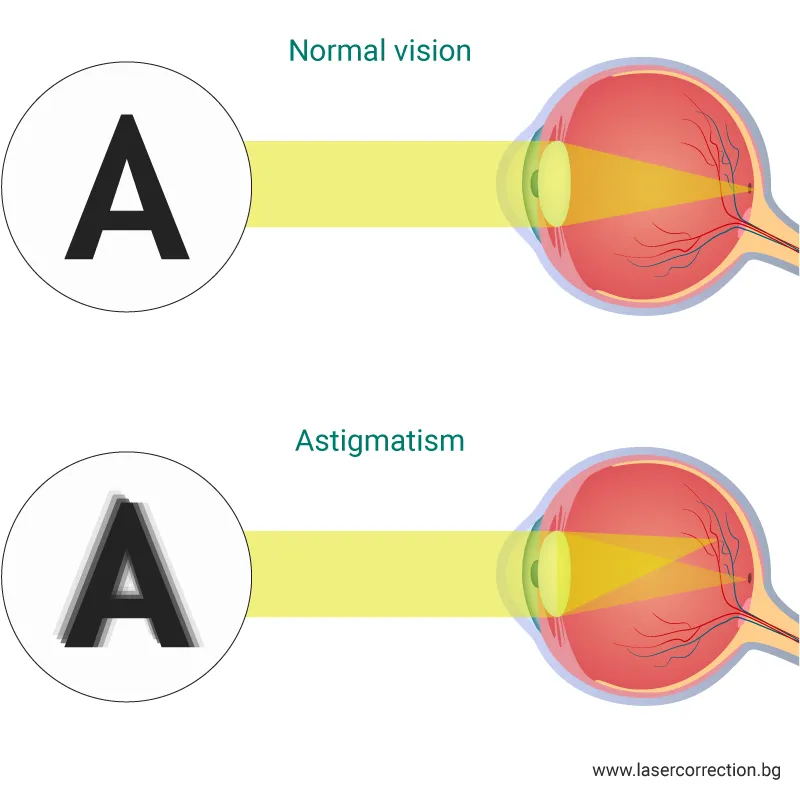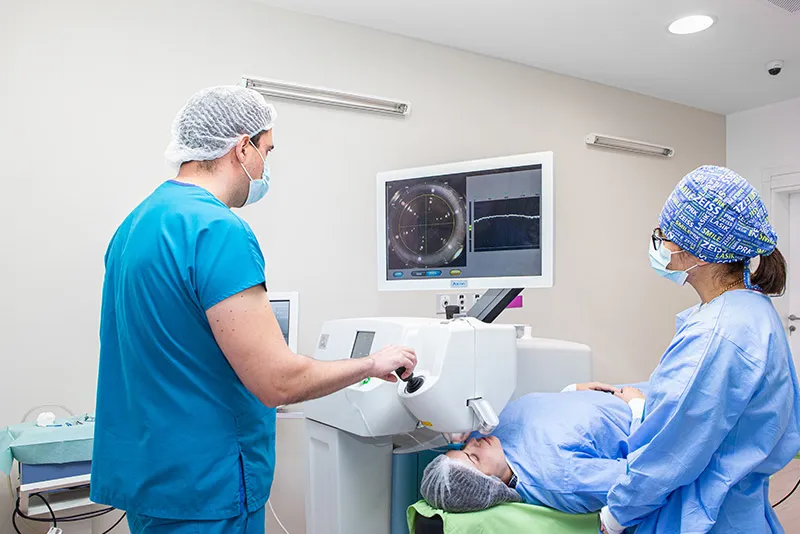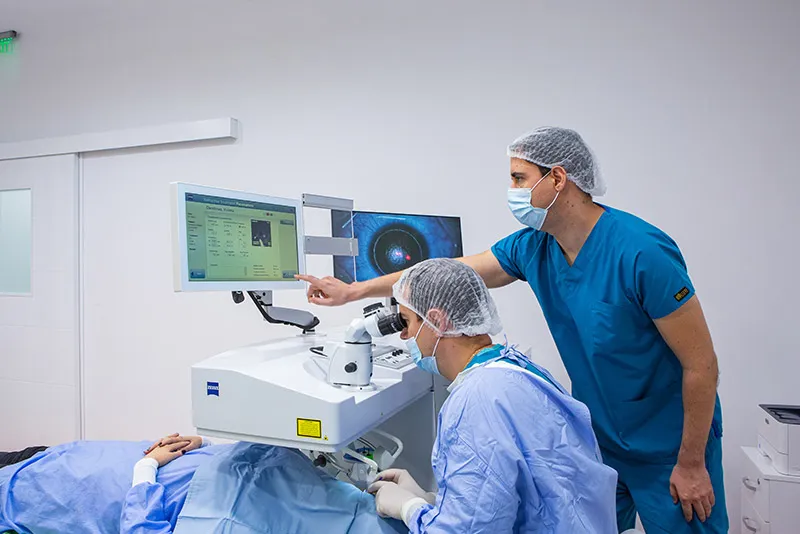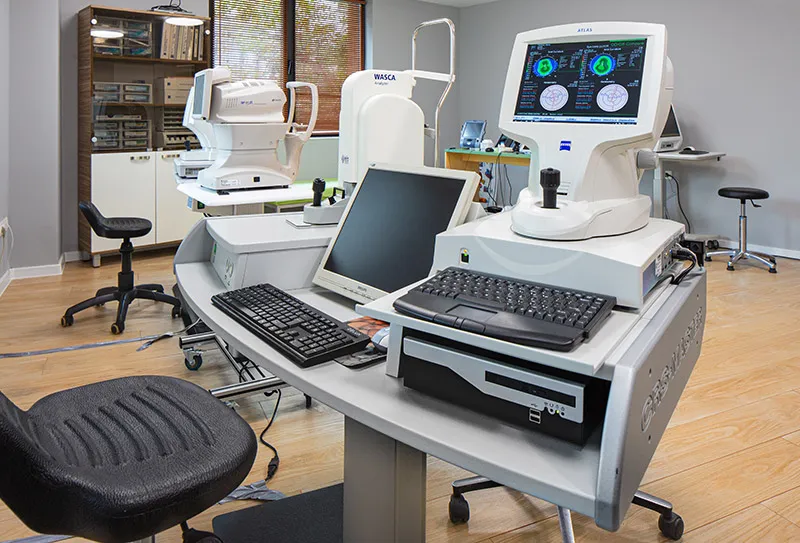Astigmatism
What is Astigmatism?
The human eye is a complex optical instrument and anomaly in any of the interrelated elements of this system results in impaired vision. Astigmatism is a condition, where the images are blurred due to irregular shape of the cornea. In this case the cornea is not completely round, but has elongated shape. Therefore the light is refracted in 2 separate points, as very often neither of them is focused on the cornea. This results in blurred vision both at far and close distance. The astigmatism may be combined with other visual pathologies, such as Nearsightedness (Myopia), Farsightedness.
Astigmatism

Astigmatism
Normal eye

Normal eye
All types of astigmatism can be corrected with glasses, contact lenses or refractive surgery.
Symptoms of Astigmatism
If you have astigmatism, you may experience the following symptoms:
- Tiredness and discomfort in the eyes
- Blurred or distorted vision
- Headache
- Impaired night vision
- Eye crossing or squinting
- Decreased working capacity
The mild form of astigmatism can be unnoticeable. The first symptom is slightly blurred vision. Adults with higher degree of astigmatism can notice that their vision is not that good by observing a number of symptoms in their everyday life. Untreated astigmatism can seriously affect your professional or sport career. If astigmatism diopter progresses with time in working age people, it can be a sign of the eye disease Keratoconus. In retired people progressive development of astigmatism is usually the first symptom of Cataract
Astigmatism is observed not only in adults. Children with symptoms of astigmatism may not realize that they have such condition. You should plan preventive visits to ophthalmologist for both, and your child, because astigmatism may the reason for the headache, which makes the child nervous and hot-tempered.
Type of Astigmatism

In astigmatism, instead of one, there are two focus points, which determine two main axes refracting the light differently. The type of astigmatism is determined by the location of the axes, and also by the ratio between the focal points and the retina.
- Regular astigmatism: The two axes are perpendicular at 90 degrees and 180 degrees, as the one at 90 degrees refracts the light more
- Against-the-rule astigmatism: The two axes are perpendicular at 90 degrees and 180 degrees, as the one at 180 degrees refracts the light more
- Oblique astigmatism: The two axes are perpendicular, but inclined, most often at 45 and 135 degrees
- Simple astigmatism: the first focal line is on the retina, while the other is located behind or in front of the retina
- Simple myopic astigmatism: the first focal line is on the retina, while the other is in front of it, like in nearsightedness
- Simple hyperopic astigmatism: the first focal line is on the retina, while the other is behind it, like in farsightedness
- Compound astigmatism: both focal lines are behind or in front of the retina
- Compound myopic astigmatism – both focal lines are located in front of the retina, like in nearsightedness
- Compound hyperopic astigmatism – both focal lines are located behind the retina, like in farsightedness
- Mixed astigmatism: one focal line is in front of the retina, the other behind it
Treatment of Astigmatism
For patients at age 18 – 40 years the preferred treatment is laser correction of astigmatism. This method is completely safe, bloodless and sutureless. You can find more information at Laser correction of Astigmatism.
In patients above 40 years of age there is another method for correction of astigmatism. The implantation of soft multifocal lenses offers excellent vision and prevention of eye diseases, which may appear with the age. The intraocular multifocal lenses with toric component compensate the astigmatism and may eliminate completely the patient’s dependency on glasses and contact lenses.
Laser correction of Astigmatism
Eye Clinic Luxor has many years of experience in treatment of astigmatism with laser correction of the vision or with implantation of multifocal lenses. More than 30 000 patients trust our professionalism each year, as more than 2000 patients are operated in the hospital. Depending on your age, vision and specific needs, we can offer you the best option for your excellent vision.


Other refractive errors
In addition to astigmatism, other refractive errors are:
Farsightedness (Hyperopia)
This is a condition, in which the cornea has too little curvature or the eyeball is shorter than the normal. When the eye is relaxed the light never focuses on the retina, but behind it. The symptoms of farsightedness are determined by the age of the patient and the degree the condition, and include headache, unclear vision at close distance and blurred vision at close and far distance.
